Der Kreis is a circle. Der Teufel is the devil. When you’re trapped in a hopeless situation and can’t get out of it no matter which way you run, you’re stuck in a Teufelskreis: a Catch 22 situation or a vicious circle.
The Kinder Egg
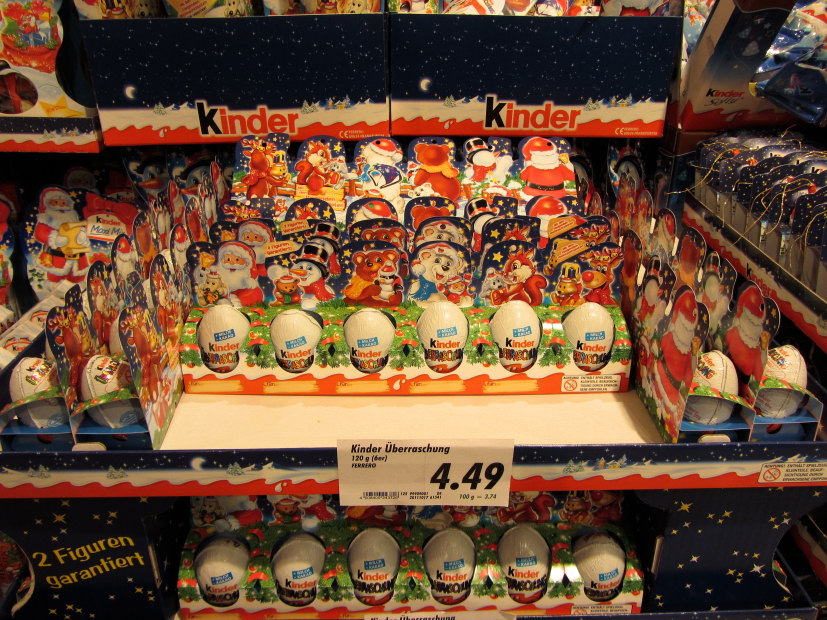
The Kinder Egg is a uniquely European treat. Made by the Italian company Ferrero since 1972, they’re a huge seller in Germany to kids and collectors alike. Collectors have been known to shake, weigh, and listen to their eggs before they buy in order to find the higher-quality toys packaged in every seventh egg.
Incidentally, Kinder Egg is not the name of the product. Its real name in Germany is Kinder Überraschung (Children’s Surprise). Kinder Egg (Kinder Ei) just happens to be what everybody calls it.
So let’s find out what’s in an egg.
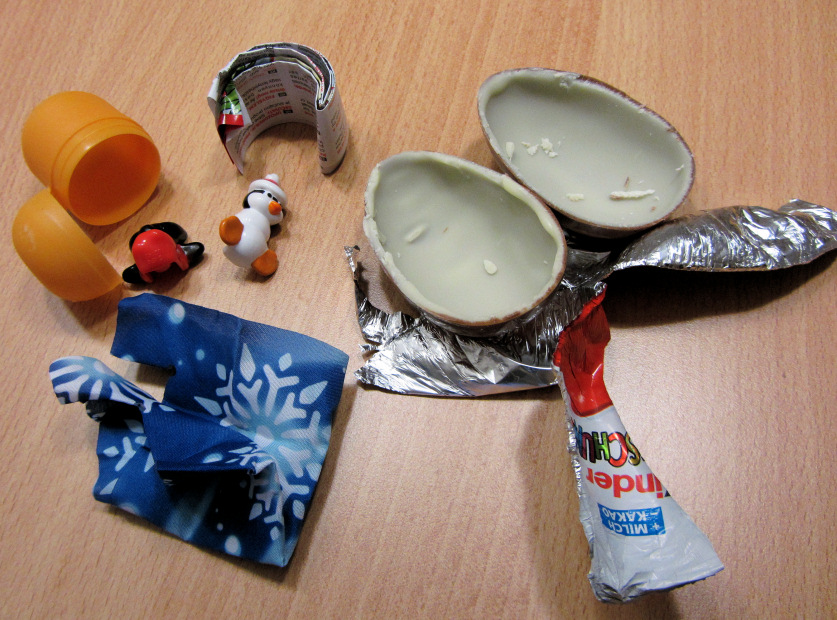
Under the wrapper is a candy shell made out of white and milk chocolate. Inside that is a thing that looks like a time capsule. From it, I pulled toy parts and what appears to be an inordinately large wad of paper. Being a writer, I’m naturally going to examine the paper first.
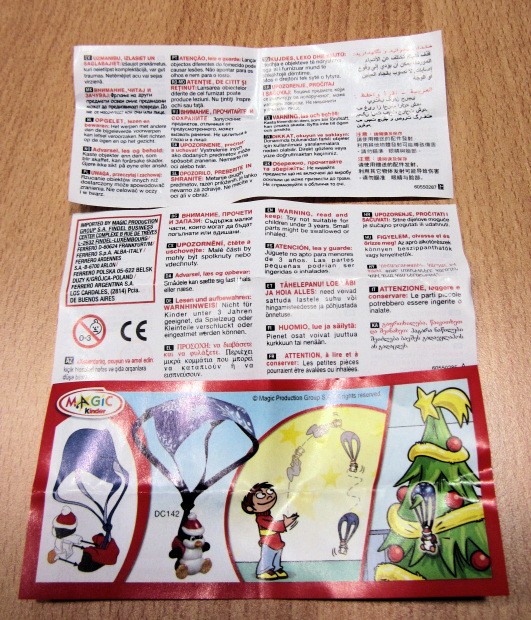
There’s a pictorial instruction sheet that also has a code for an Internet game. Besides that are two separate warning sheets printed in thirty-seven (count ’em) THIRTY-SEVEN different languages. Now I’m afraid to go near the egg.
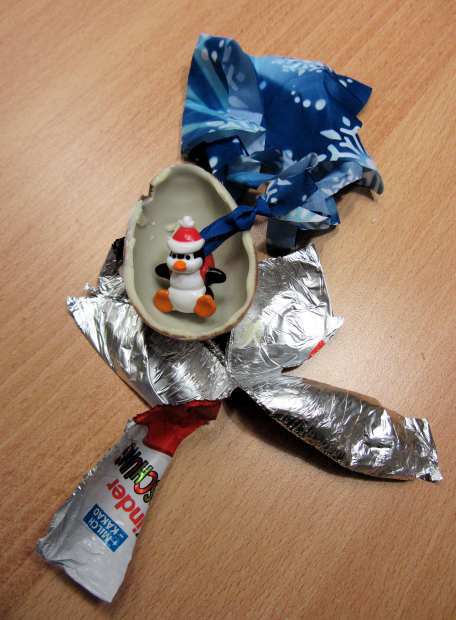
It turns out that I’m the proud owner of a parachuting penguin. How well does it work? Let’s just say that penguins still haven’t mastered flight. I guess I should have shaken my egg.
Maybe you’re in Europe, and you want to buy some Kinder Eggs to take home to the family. Don’t do it. This simple act of charity will transform you into an international smuggler. United States law forbids the sale or importation of Kinder Eggs. They’re considered a choking hazard. Since 1989, at least seven deaths have been reported worldwide as a result of children choking on Kinder Egg parts. So customs agents have been known to confiscate Kinder Eggs out of people’s luggage. Good! No sacrifice is too great to keep us safe.
On the other hand, since 1973, over a hundred and ten children have died in the US alone as a result of choking on latex balloons. Hmm. We have nothing to fear but spheres themselves.
To read my latest blog posts, please click on the “Green and Pleasant Land” logo at the top of this page. Photos taken in November, 2011, in Kaiserslautern and Rodenbach, Germany. Text and photos copyright 2011 by Clare B. Dunkle.
The other day, my daughter commented on how confusing the mir ist construction can be. In lots of cases where we say, “I am,” in English, Germans say mir ist or ist mir — “it seems to me.” So, they say, “Mir ist kalt” — “It seems cold to me” — rather than “I’m cold.” Mir ist can also mean “From my point of view, it’s…” So Germans say, “Es ist mir wichtig” — “From my point of view, it’s important.” Or they say, “Es ist mir klar” — “From my point of view, it’s obvious.” Germans even talk about illnesses this way: mir ist schwindlig — I feel dizzy.
This can lead to some humorous misunderstandings. If we say, “Mir ist langweilig,” that means, “I’m bored” or “This seems boring to me.” But if we say, “Ich bin langweilig,” what we’re saying in German is “I’m a boring, tedious person.” Let’s hope nobody nods and agrees!
What Happened to Two Minutes of Silence?
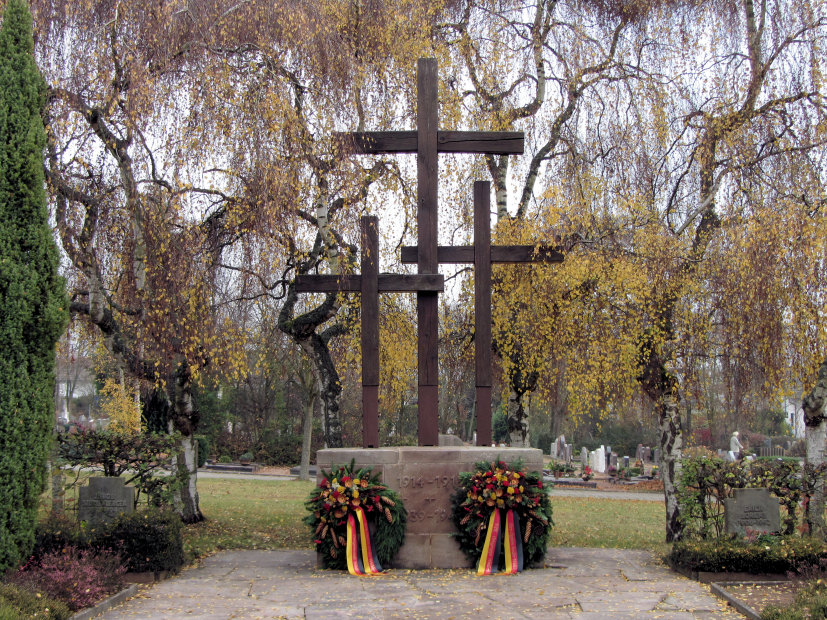
Foreigners find it almost shocking that Germans dance in the streets on Veteran’s Day. It’s the anniversary of the end of World War I. How can that possibly call for a celebration?
First of all, Germans certainly honor their veterans. Every town has a monument to its fallen soldiers; Weilerbach, where I took these photos, has four. Germany’s Memorial Day, called Volkstrauertag, takes place on a Sunday in mid-November. Various bans against public celebrations are in effect on that day.
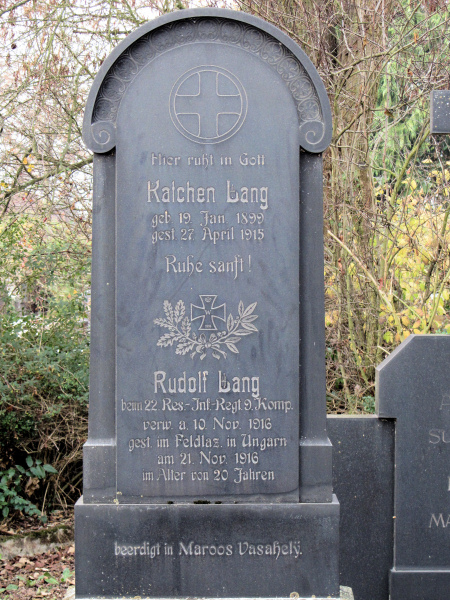
Yes–but why the party on November 11, the actual Armistice Day?
It’s important to remember that “Germany” doesn’t celebrate Carnival any more than “America” celebrates Mardi Gras. Carnival belongs principally to the Rhenish Catholic tradition and its cities–above all, the great Carnival city of Cologne (Köln).
Cologne enjoyed 500 years as a completely free city–its own state within the Holy Roman Empire. It lost that status in 1798 when the French occupied it. In 1815, the French handed Cologne over to Prussia, and Protestant Prussia’s repressive policies towards the Catholic Church contributed to strong anti-Prussian sentiments in the Rhineland for decades. Meanwhile, Prussia consolidated its territory into the German Empire.
During all this time, the Cologne Carnival (Kölner Karneval) went on: a celebration of the spirit of Cologne itself, no matter who ruled it or how it was spelled. During the First World War, Carnival stopped, and after the war, Cologne was held by the British. But as soon as the British left, Carnival started back up on the same date as always: 11-11, the Fool’s day.
Germans don’t associate 11-11 with war for excellent reasons. When Armistice Day occurred in 1918, the Emperor had just abdicated, so Germany was in a state of confusion. Also, the war didn’t officially conclude until the Treaty of Versailles months later. So, for Germans, the cease-fire date got lost in the shuffle.
Meanwhile, it was the Allies who celebrated Armistice Day–at first, with parades through the streets. But the loss of life had been too high for jubilation. In 1919, the first two minutes of silence took place in Great Britain, and it fit the public mood much better.
Britain’s allies have observed the day with silence ever since.
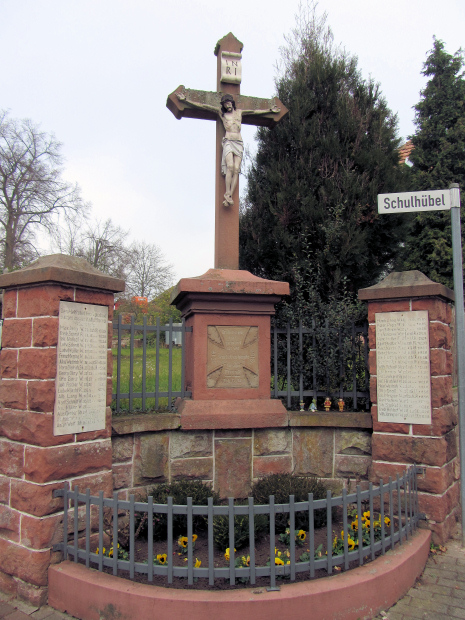
To read my latest blog posts, please click on the “Green and Pleasant Land” logo at the top of this page. Photos taken in November, 2011, in Weilerbach, Germany. I apologize for the lack of citations: I gleaned this information a tiny piece at a time from German-language and English-language sites all over the web. Text and photos copyright 2011 by Clare B. Dunkle.
Yesterday, I read this promise in an insurance advertisement: “Wir lassen Sie nicht allein” — “We don’t leave you alone.” Having been besieged before by insurance agents who wouldn’t stop calling, I found the sentence a little alarming. But a German wouldn’t read it that way. If Germans want to be left alone, they don’t say, “Leave me alone.” They say, “Lass mich in Ruhe” — “Leave me in peace.”
11-11-11 (at 11:11 o’clock)
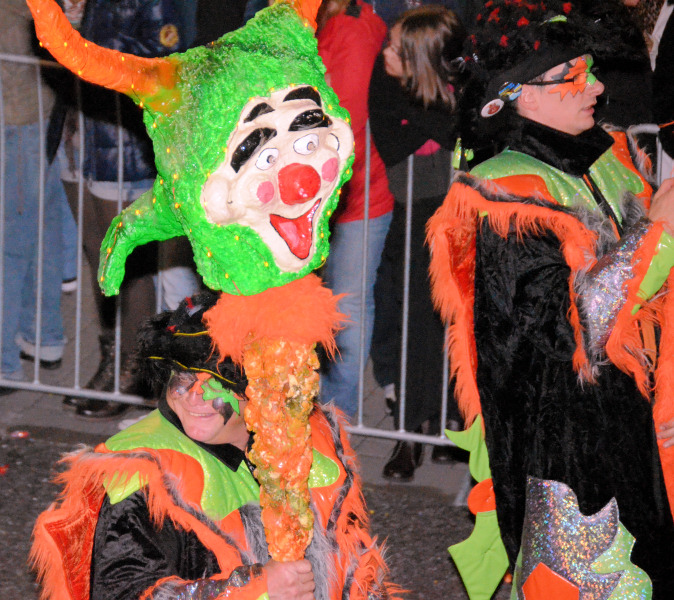
St. Martin’s Day (Martintag), November 11, kicks off the beginning of German carnival season, called Fasching, Fastnacht, Fastelabend, or Karneval, depending on where you live. But as soon as it’s begun, Fasching vanishes, only to reappear after Christmas. Why the long break in this legendary “fifth season”? And why the love affair with elevens?
In Germany, eleven has long been considered a funny number. The word elf means either eleven or a pixie, so that gives it a flavor of magic right there. Then, it’s the only common number that was a different common number under the old Roman system, which wasn’t abandoned until the Middle Ages. And the origin of elf means “one more than ten,” so it’s a clumsy addition to a perfect number. Because of this, eleven is considered the “fool’s number.” And Fasching is all about the Fool.
In the early 1800’s, in the great carnival city of Cologne, the day of 11-11 became the “alarm clock” for Fasching. The Fools (Narren or Jecken) showed up in the streets to warn the guilds that it was time to start work on their carnival floats and costumes.
But Martintag was already a party day long before then.
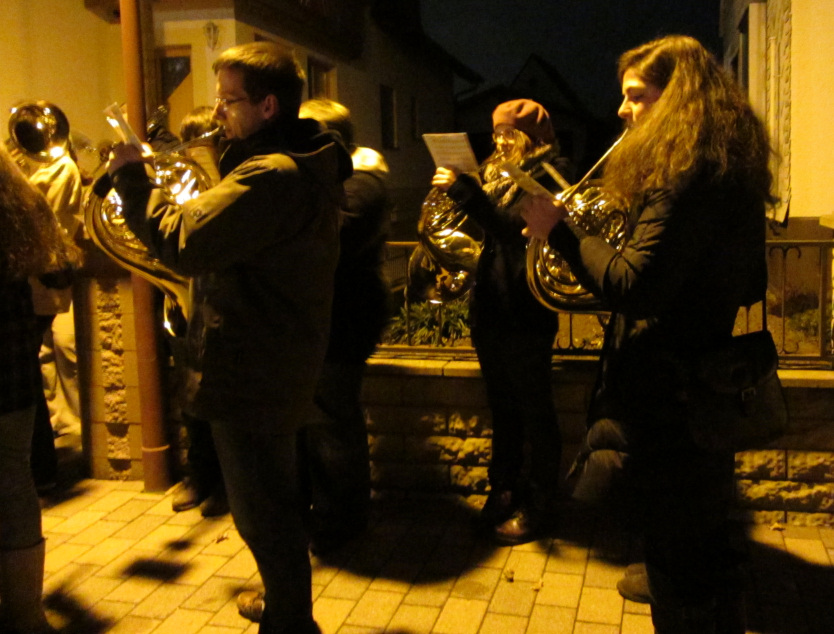
Before the Middle Ages, Martintag belonged to a carnival season of its own. Back then, the Advent season before Christmas was like Lent: forty days of fasting. By Martintag, the weather was cold enough to slaughter the animals, but fasting was just around the corner. So the Germans had their harvest celebration on Martintag and partied like it was Mardi Gras time.
As the centuries passed, Advent shrank and became less austere. But that was no reason to stop a good party.
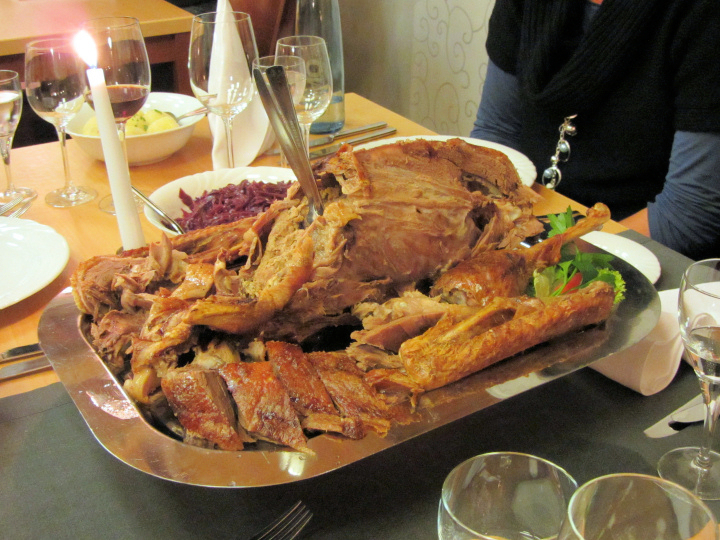
Germans still eat a goose around Martintag, so Joe and I went with friends to try it out. We feasted the whole evening on roast goose with pâté stuffing, chestnut dressing, potato dumplings, and red cabbage. It was lovely! Goose isn’t as dry as turkey, and the thick, fatty skin tastes like pork rinds. Chestnuts taste a little bit like yams.
On Wednesday: What happened to two minutes of silence?
To read my latest blog posts, please click on the “Green and Pleasant Land” logo at the top of this page. Photos taken in October and November, 2011, in Kaiserslautern and Rodenbach, Germany. Text and photos copyright 2011 by Clare B. Dunkle.
The other night, I was asking Heidi about the Kaiserslautern Zoo. “It’s nice,” she said. “Of course, it’s not a big zoo. But they have two lions, and lots of smaller animals. They have a petting zoo with goats and horses. And they have Erdmännchen.”
“Erdmännchen?” I was immediately captivated. I knew die Erde means the earth or the ground and das Männchen means a manikin or fairy-tale dwarf. “What kind of animal is an Erdmännchen?”
“Oh, you know, they live in the ground, in big groups, and they all stand up together and look around.”
Das Erdmännchen is a meerkat!
Lighting Up the Night
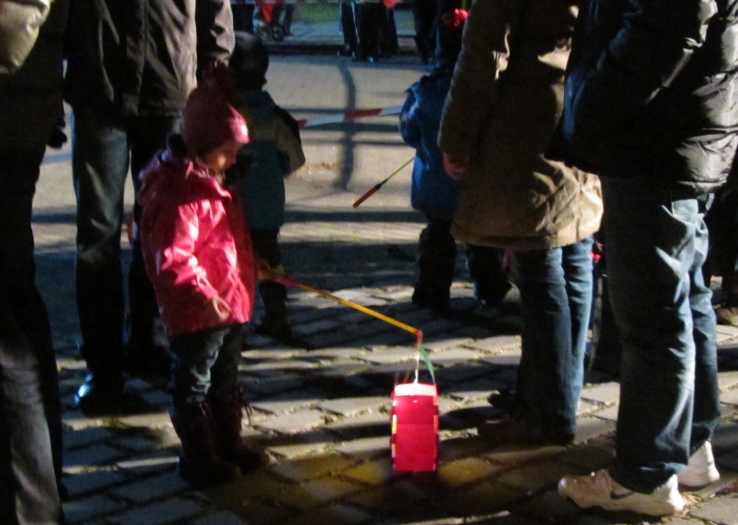
Having mourned the death of the day, Germans now start having fun with the night. They traditionally celebrate November 11th, St. Martin’s Day, with a nighttime children’s parade (Martinsumzug). Rodenbach has a population of only three thousand. Nevertheless, hundreds showed up for the annual event.
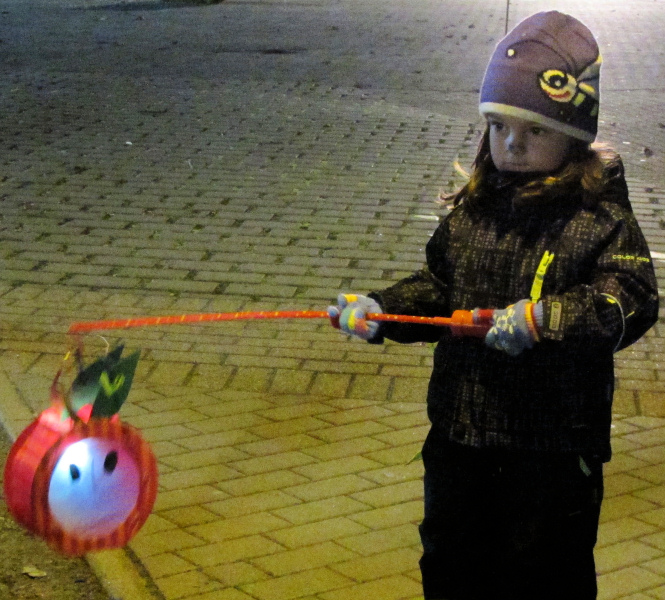
Each child had a lantern to carry in the parade, many of them made in school or preschool. The majority of the children were young enough to be completely fascinated by their lanterns. In old days, the lanterns held a candle, but now they have a little light bulb inside.
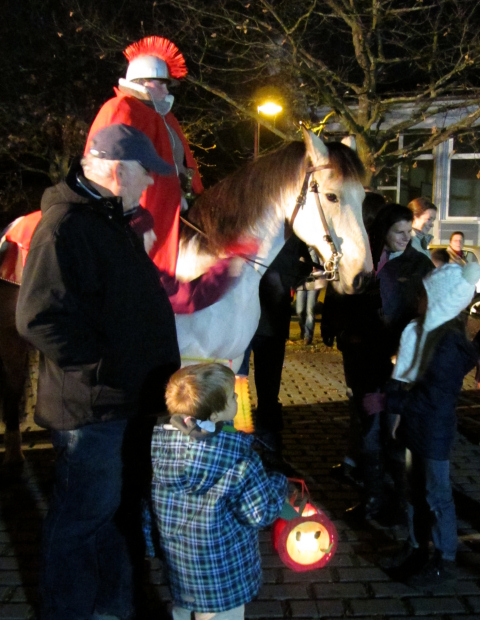
St. Martin himself was there, of course, wearing his famous red cloak, although the real star of the show was his horse, who was very patient with his admirers. Tradition has it that St. Martin had such pity on the poor that he once cut his cloak in half to share it with a shivering beggar. That night, he dreamed that he had given the cloak to Christ Himself. So, before the parade, a narrator read this story while St. Martin and a “beggar” reenacted it. Then they put his cloak back together so he could wear it in the parade. What they did before the days of Velcro, I do not know.
The parade consisted of all several hundred of us walking at little-child speed after St. Martin and the Rodenbach firemen (the Feuerwehr). It lasted a good half hour, and I was impressed at how well the children handled it. The lanterns didn’t always hold up as well. Being made of paper, they sometimes came apart rather dramatically, but the moms and dads usually got them working again. Three quarters of the way through, we stopped to listen to a brass band play St. Martin’s Day songs.
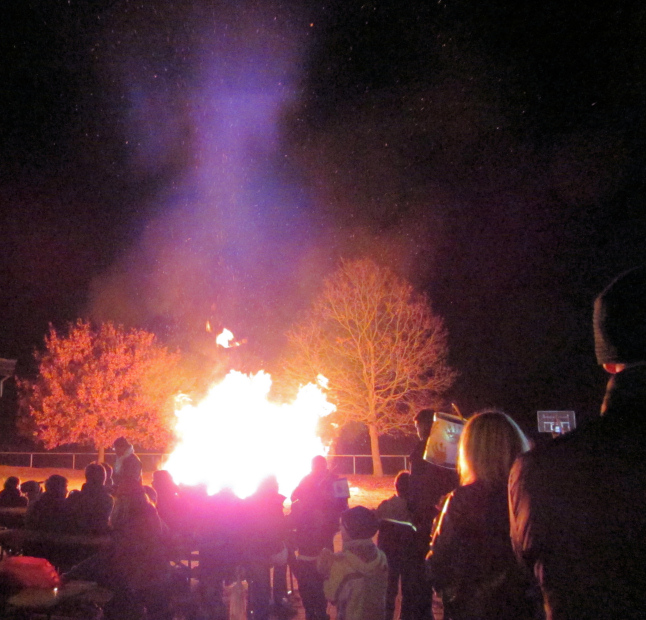
We returned to the park to discover an enormous bonfire blazing there. No wonder the firemen were invited! Glühwein and large sweet pretzels were for sale, with all proceeds benefiting an African soup kitchen. In this photo, the glow of the fire hovers like a benediction over the crowd. How wonderful to think of a life so well lived that people still help the poor in its honor 1,600 years later.
To read my latest blog posts, please click on the “Green and Pleasant Land” logo at the top of this page. Photos taken in November, 2011, at the
St. Martin’s Day parade (St. Martinsumzug) in Rodenbach, Germany. Text and photos copyright 2011 by Clare B. Dunkle.
On St. Martin’s Day, little children parade through the streets after dark, singing,
Ich geh’ mit meiner Laterne
Und meine Laterne mit mir.
Dort oben leuchten die Sterne,
Hier unten, da leuchten wir.
I go with my lantern,
and my lantern goes with me.
Up above, the stars are shining;
here beneath, there shine we.
Die Laterne is the lantern, the most memorable part of the St. Martin’s Day children’s festivities.
That’s Typical
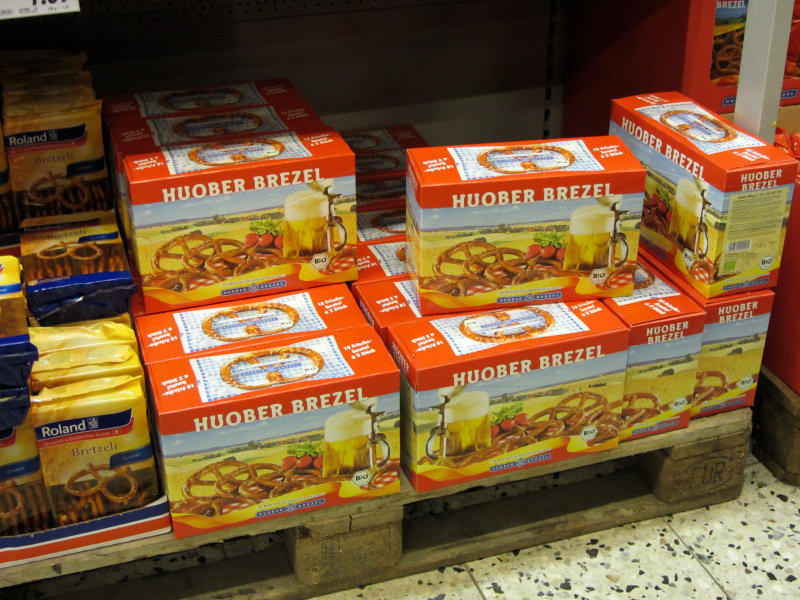
When we hear of a food typically associated with a country, we often ask ourselves, “Yes, but do the locals eat that? Or do they just sell it to us?” Haggis and lutefisk come to mind immediately, but I remember hearing an Irishman declare that he and his fellow citizens would sooner die than eat Irish stew. So I thought I’d take a camera to the German supermarket to answer a few basic questions.
Do Germans eat pretzels? Yes, they do: big soft pretzels, tiny hard pretzels, and pretzels dipped in chocolate. On a recent Lufthansa flight, I was disappointed to receive a soft pretzel as a snack until I realized it was filled with real butter (17%). That was a pretzel I could appreciate!

Do Germans eat gummy bears? Oh, yes. Invented in 1922, gummy bears are the M&M’s of Germany. Germans of every age and class tuck them into lunch bags and hide them in desk drawers. You’ll find them for sale wherever candy is sold. As the photo shows, Haribo makes an astounding array of other gelatin candies, and so does Trolli, their leading competitor. Between the two, they take up half an aisle.
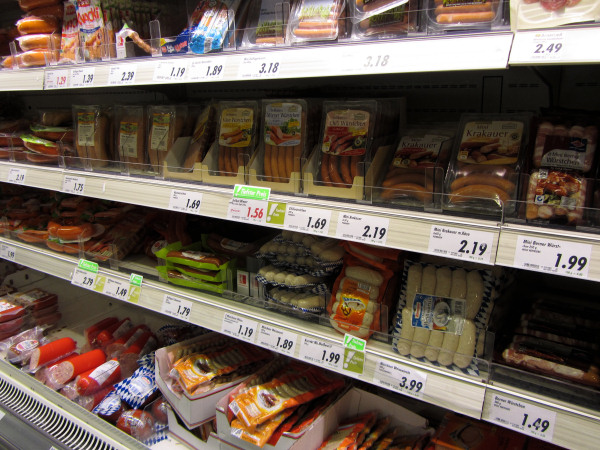
Do Germans eat wurst (sausage, hotdogs, brats)? Yes.
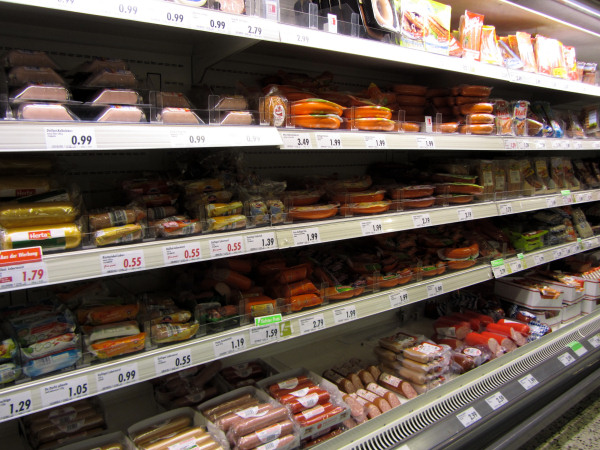
And yes.
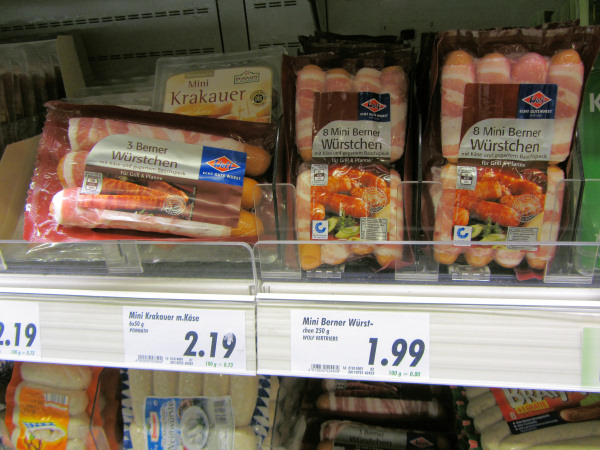
And yes. My husband declares that this bacon-wrapped, cheese-filled wurst may just be nature’s most perfect food.
Still, there are some grim statistics wrapped up in that decorative slice of bacon. According to the most recent statistics I could find (2006-7), heart disease is responsible for almost half of all deaths in Germany. In fact, in this gloomy category, Germany has us beat: 224 deaths per 100,000 over America’s 199 deaths per 100,000.
That’s a good reason to leave the bacon, cheese, and wurst on the shelf.
To read my latest blog posts, please click on the “Green and Pleasant Land” logo at the top of this page. Photos taken in November, 2011, at the Globus supermarket in Kaiserslautern, Germany. Text and photos copyright 2011 by Clare B. Dunkle.
